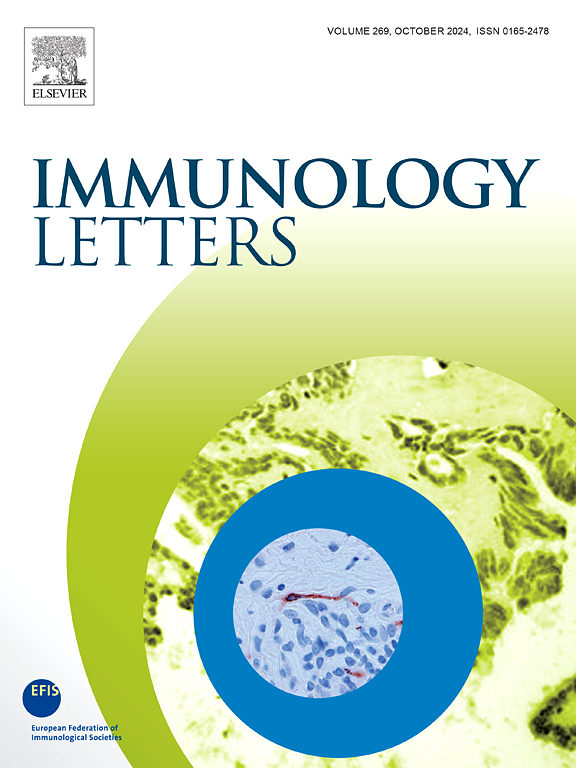意大利肌炎特异性和肌炎相关自身抗体的季节性模式:肌炎自身抗体的季节性模式。
IF 2.8
4区 医学
Q3 IMMUNOLOGY
引用次数: 0
摘要
目的:特发性炎症性肌病(IIM)是一组异质性的全身性自身免疫性疾病,不仅影响骨骼肌,还影响其他器官。特发性炎症性肌病有多种形式,每种形式都有独特的临床表现和预后。因此,在 IIM 中出现了几种自身抗体,不同形式的疾病有不同的发病率。虽然环境因素在易感基因个体的发病中肯定起到了诱发作用,但 IIM 的发病机制仍不清楚。支持这一观点的一些报道表明,IIM 的发病率在一年四季中可能有所不同。在这项工作中,我们测试了在 IIM 中通常观察到的自身抗体的检测是否具有季节性:我们收集了 2018 年 1 月至 2020 年 12 月期间意大利十家医院对 4277 名疑似 IIM 患者进行的线性免疫测定(LIA)的血清学数据。结果:我们的研究结果表明,肌炎特异性抗体和肌炎相关自身抗体的绝对数量与肌炎的发病率成正比:我们的研究结果表明,抗MDA5、抗PM-Scl75、抗Mi2b和抗TIF1ɣ自身抗体的绝对数量在秋冬季比春夏季更容易检测到。然而,在分析阳性检测频率时,只有抗PM-Scl75和抗MDA5显示出相似的模式(抗PM-Scl75在9月至2月期间有100例阳性检测和2107例阴性检测;在3月至8月期间有55例阳性检测和1903例阴性检测,p=0.003;抗MDA5在9月至2月期间有34例阳性检测和1983例阴性检测;在3月至8月期间有17例阳性检测和1760例阴性检测,p=0.051):这些发现表明,促进这些自身抗体产生的诱因具有特定的季节性。本文章由计算机程序翻译,如有差异,请以英文原文为准。
Seasonal patterns of myositis-specific and myositis-associated autoantibodies in Italy
Objective
Idiopathic inflammatory myopathies (IIM) are a heterogeneous group of systemic autoimmune disorders affecting skeletal muscles but also other organs. There are different forms of IIM, each with peculiar clinical manifestations and prognosis. Accordingly, several autoantibodies have been described in IIM, with different prevalence in the different forms of the disease. The etiopathogenesis of IIM is still unclear, although environmental agents play certainly a role to trigger disease development in genetically predisposed individuals. Supporting this notion, some reports suggest that the incidence of IIM may be different throughout the year. In this work, we tested if the detection of autoantibodies typically observed in IIM has a seasonal pattern.
Methods
We collected serological data from line immunoassays (LIA) performed on 4277 patients with suspected IIM from January 2018 to December 2020 in ten Italian hospitals. Myositis-specific and myositis-associated autoantibodies were evaluated by line-immunoassay.
Results
Our findings demonstrate that absolute numbers of anti-MDA5, anti-PM-Scl75, anti-Mi2b and anti-TIF1ɣ autoantibodies are more frequently detected in autumn-winter than in spring-summer. However, only anti-PM-Scl75 and anti-MDA5 display a similar pattern when analyzing frequencies of positive tests (for anti-PM-Scl75 100 positive tests and 2107 negative tests from September to February; 55 positive tests and 1903 negative tests from March to August, p = 0.003; for anti-MDA5 34 positive tests and 1983 negative tests from September to February; 17 positive tests and 1760 negative tests from March to August, p = 0.051).
Conclusions
These findings suggests that triggering agents promoting the development of these autoantibodies have a specific seasonal pattern.
求助全文
通过发布文献求助,成功后即可免费获取论文全文。
去求助
来源期刊

Immunology letters
医学-免疫学
CiteScore
7.60
自引率
0.00%
发文量
86
审稿时长
44 days
期刊介绍:
Immunology Letters provides a vehicle for the speedy publication of experimental papers, (mini)Reviews and Letters to the Editor addressing all aspects of molecular and cellular immunology. The essential criteria for publication will be clarity, experimental soundness and novelty. Results contradictory to current accepted thinking or ideas divergent from actual dogmas will be considered for publication provided that they are based on solid experimental findings.
Preference will be given to papers of immediate importance to other investigators, either by their experimental data, new ideas or new methodology. Scientific correspondence to the Editor-in-Chief related to the published papers may also be accepted provided that they are short and scientifically relevant to the papers mentioned, in order to provide a continuing forum for discussion.
 求助内容:
求助内容: 应助结果提醒方式:
应助结果提醒方式:


